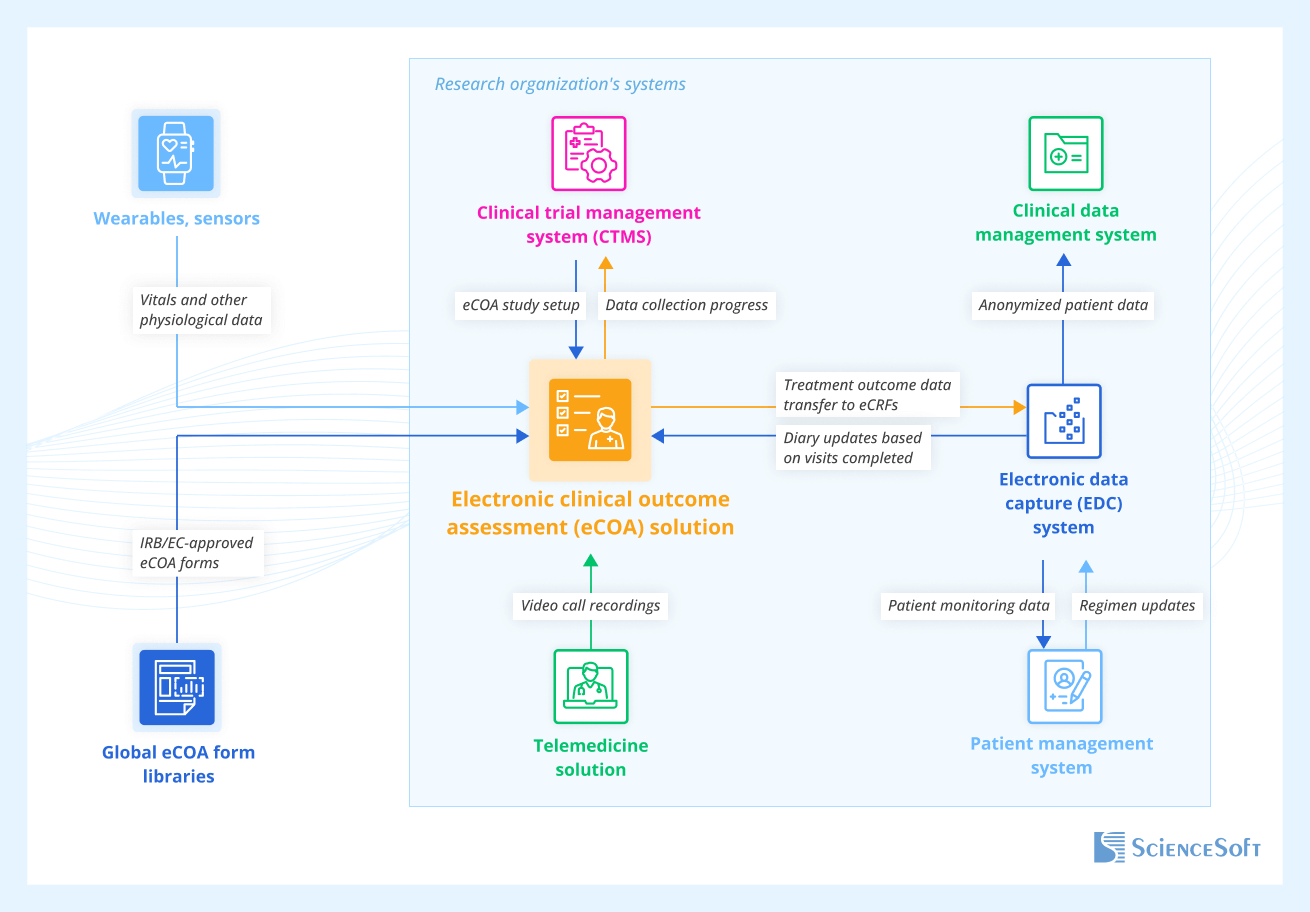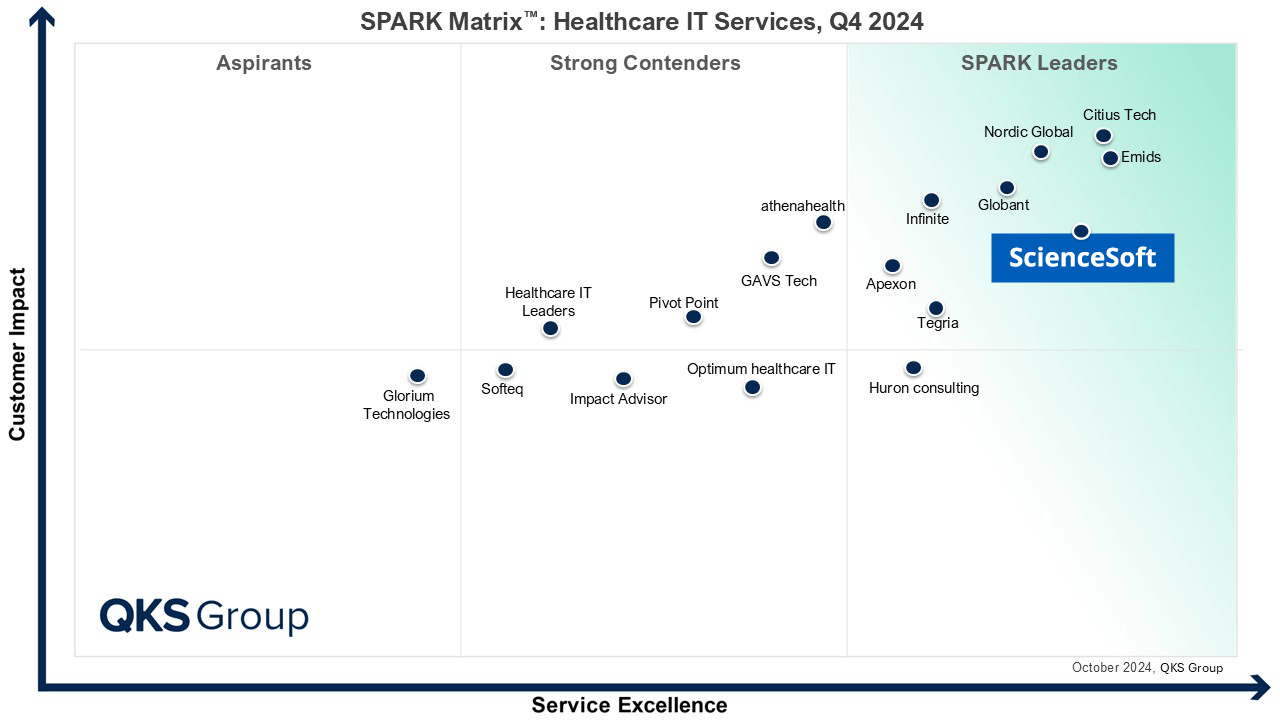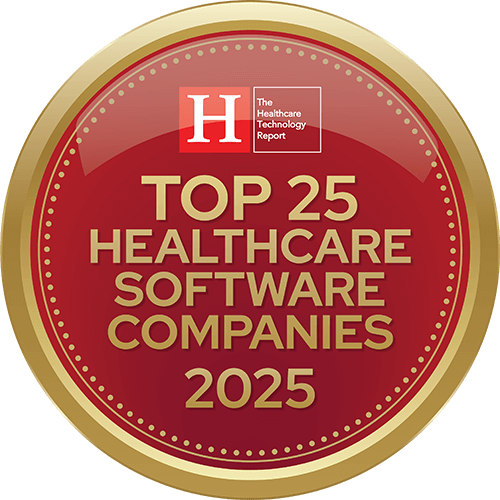Electronic Clinical Outcomes Assessment Software
Features, Development Roadmap, and Costs
In healthcare IT since 2005, ScienceSoft engineers compliant eCOA solutions that can be securely integrated with internal and partner systems, including clinical trial management (CTMS), electronic data capture (EDC), telemedicine platforms, and more.
Custom Electronic Clinical Outcomes Assessment Software at a Glance
Electronic clinical outcomes assessment (eCOA) software is used in clinical trials to capture data on treatment efficacy and safety during on-site visits or remotely, either through patient self-reports or evaluations conducted by trained clinical raters.
Demand for eCOA is growing as more clinical trials move to remote or hybrid (on-site and remote) data collection models (expected to reach 80-90% by 2027). Patients appreciate the comfort of sending data from their homes, and as a result, eCOA helps to achieve over 80% to 90% patient compliance.
Custom eCOA software development is a way to overcome the challenges clinical trial sponsors and contract research organizations (CROs) face with off-the-shelf solutions:
- The lack of flexibility in off-the-shelf eCOAs for implementing protocol-specific measurement strategies.
- Overlaps between the features of out-of-the-box eCOAs and the clinical research systems already in place, which results in workflow duplications or automation inefficiency.
- Difficulties in integrating off-the-shelf eCOA software with existing systems and wearable devices.
Custom eCOA implementation time: 8 to 12+ months.
Useful integrations for eCOA software: clinical trial management system (CTMS), an electronic data capture (EDC) system, a telemedicine solution, and wearables or sensors for patient monitoring.
Costs: $150,000–$500,000+, depending on complexity. Use our free calculator to get a tailored estimate for your eCOA project.
Sometimes, this type of software can be called ePRO (electronic patient-reported outcomes). The difference is that eCOA is a broader term; it covers any digital means of collecting data about patients' condition, symptoms, and treatment effects, and can include the capturing of patient-reported outcomes (PRO), clinician-reported outcomes (ClinROs), observer-reported outcomes (ObsRO), and performance outcomes (PerfO).
Core Functionality for an eCOA Solution
For study administrators and designers
- Creating an eCOA study using a builder that includes screen templates, drag-and-drop tools for setting workflows, and customizable widgets for rating scales, reference images, automated calculations, etc.
- Preview of the created assessments on different screens and automatic generation of screenshots and relevant documentation.
- Setting up branching logic (changing question sequences based on previous answers), mandatory fields, edit checks, and other rules to ensure integrity of the entered data.
- Access to a global library of reusable and adjustable IRB/EC-approved eCOA forms, licensing agreements, translations, etc.
- A translation management tool for maintaining the eCOA form translation database.
- Flexible mid-study eCOA assessment editing according to study protocol changes.
For patients and caregivers
- Dashboards for accessing study tasks (such as taking medications, conducting measurements, and filling out diaries).
- In-app reminders and alerts for completing study tasks.
- Diaries with built-in prompts and tips (e.g., skipping the symptom severity rating when there's no symptom, re-checking the invalid dose value, and revisiting missed fields) and an offline mode for completing tasks from anywhere.
- Adding photos (e.g., images of skin eruptions) and audio recordings to diary entries.
- Receiving real-time feedback based on entered health data (e.g., the instruction to take symptomatic medication or contact the investigator if a side effect occurs).
- Reviewing the data collected by connected variables and sensors (e.g., blood sugar levels over a week).
- Training materials on how to use a diary and provisioned device (e.g., in-app training course, video tutorials).
- Accessibility features based on participant needs (e.g., screen magnification and voice control for patients with vision impairments).
For raters
- Dashboards for accessing patient profiles, hospital visit and assessment schedules, etc.
- eCOA forms with an advanced navigator for tracking completion progress, navigating sections, skipping ahead, revisiting unfinished areas, etc.
- Annotating forms by typing, handwriting, and adding images or files.
- Voice note-taking with auto-transcription and adding section markers for retrospective review.
- Tooltips for eCOA form completion according to clinical guidelines.
For investigators
- Creating, editing, and terminating patient profiles.
- Patient catalog with structuring and filtering capabilities.
- Monitoring the status of individual patients and patient groups.
- Monitoring diary completion and treatment compliance rates.
- Enabling caregiver log-in for patients who need caregiver reporting or assistance.
- AI-assisted review of completed forms for missing, invalid, or inconsistent data.
- Verifying the gathered data and automatically transferring it to the study databases.
Automated data capture and quality control
- Raw data ingestion from eCOA forms submitted by patients, raters, and investigators.
- Wearable and sensor data capture (e.g., ECG data, spirometry data, blood glucose levels, heart rates).
- Real-time data validation, such as spotting invalid or out-of-range values, missing data, and discrepancies with existing records during entry.
- Patient data pseudonymization.
- Automated entry labeling with date, time, and other metadata (e.g., a day of a chemotherapy cycle).
- Controls for form filling and medication intake within designated periods with automatic patient alerts.
- Automatic calculation of clinical metrics (e.g., severity scores).
- Auto-generated patient compliance reports.
Compliance, security, and data privacy
- Role-based access control (for patients, caregivers, raters, investigators, admins, etc.).
- End-to-end data encryption at rest and in transit.
- Multi-factor authentication (MFA).
- Full audit trail of user activities, including granular data access logs.
- Data storage and transfer in compliance with 21 CFR Part 11, GCP guidelines, HIPAA, HITECH, GDPR, Cures Act, and other applicable regulations.
Need Assistance With Your eCOA Initiative?
ScienceSoft is a powerhouse of MD consultants, software architects, UX designers, and project managers experienced in healthcare and life science R&D domains. Reach out to them to learn how to make your eCOA software convenient for patients and effective at automated data processing, while proactively controlling project budgets and deadlines.
Possible Integrations for Electronic Clinical Outcomes Assessment Software

- Clinical trial management system (CTMS) — for enabling research organizations to set up the eCOA study in line with the trial protocol and track data collection progress.
- Electronic data capture (EDC) system — for automatic updating of the diary set on patient devices based on completed visits; for automatic data transfer from completed eCOA forms into patient electronic case report forms (eCRF), and then via clinical data integration pipelines into the central trial data warehouse.
- Wearables or sensors for patient monitoring — for the automated capture of the patient health-related data gathered by the devices into eCOA forms.
- Telemedicine software — to let raters conducting remote visits attach informative fragments of visit recordings to eCOA forms.
- eCOA form libraries compiled by partner research organizations — for importing IRB/EC-approved eCOA forms that may be reused or adjusted to align with the protocol.
Roadmap for Developing Custom eCOA Software
ScienceSoft creates individual roadmaps for custom electronic clinical outcome assessment (eCOA) software development for every research organization, specifying milestones, resources, risks, and preventive strategies based on the challenges of each project. Below, we provide a more general overview of the eCOA development process, which suits the most common use cases.
1.
Business analysis and requirements engineering
At this stage, business analysts conduct interviews with sponsor or CRO representatives, trial coordinators, investigators, and research associates to define the requirements for the future eCOA solution.
For example, when specifying the functional requirements, experts must consider whether patients will use provisioned devices or their own (a.k.a. BYOD approach), whether wearables will be used in the assessment process, whether data collection will rely on patient self-reports or evaluations by qualified raters, and more.
ScienceSoft's UX designers also recommend involving patients as active stakeholders to model user journeys according to their needs. For example, conversations with patients might show that when they feel worse, they perceive completing diaries as an extra burden and might procrastinate. Here's a tip from ScienceSoft’s expert to help make this easier for patients.
Drawing on my experience, I recommend designing eCOA software with an option for patients to fill out forms in parts, save their progress, and return later, even for brief five-minute diaries. This can improve compliance by supporting patients feeling overwhelmed by distressing symptoms or experiencing chronic fatigue.
2.
Compliance planning
Depending on the specifics of the organization, eCOA solutions may have to comply with the ICH Guideline for Good Clinical Practice, FDA 21 CFR Part 11, HIPAA, HITECH, GDPR, Cures Act, and other relevant regulations.
ScienceSoft’s compliance consultants point out that most regulations and standards across the world require the following key features:
- Data access controls (RBAC and multi-factor authentication).
- Encryption of all patient data both at rest and in transit.
- Record traceability controls (timestamps and audit logs for tracking all data access and actions performed).
- Data integrity verification mechanisms.
- Secure channels such as HTTPS for all data exchanges.
- Secure data backup.
3.
UX/UI design
UX/UI designers create interfaces for each user role, with a strong focus on solution usability for patients. Especially when patients fill out diaries at home, it's vital to ensure that every interface element is intuitive and can be used without needing assistance from research staff or extensive training.
Another aspect designers closely consider is software accessibility. For instance, assessments for patients with fine motor skill difficulties should include preset answer options on large buttons instead of typing. Or, for patients with light sensitivity, screens should have a dark mode option.
4.
Development and testing
Typically, ScienceSoft’s project managers suggest an iterative approach to healthcare software development, meaning the features are delivered incrementally so that site staff, sponsor representatives, and pilot users among patients can try using the solution and provide feedback.
QA is carried out in parallel with development, and previously existing functionality is re-tested to make sure it wasn’t affected by new additions (during regression testing). Along with routine functional testing, the QA team may perform integration, performance, and security testing for big releases and updates.
ScienceSoft’s experts also provide consultations on user acceptance testing for finished custom eCOA software, which is often required by regulations. Our engineers can confirm that the testing plan validates the software usability from both the patient and site perspectives and suggest potential updates based on testing results.
5.
Deployment and support
After the eCOA launch, the development team must provide support to medical staff and patients from day one to promptly address any issues or questions. For projects spanning large-scale, multicenter studies, a dedicated support team and a 24/7 help desk for patients and sites are generally necessary.
The support team also assists the research staff in adopting the new eCOA solution by providing written and video tutorials and offering group and individual consultations. Over time, the maintenance team monitors the performance of eCOA software, analyzes user feedback, and fixes any remaining issues.
How Much Does It Cost to Develop Custom eCOA Software?
The costs of developing eCOA software range from $150,000 to over $500,000. The final figure is primarily driven by the number of integrations (e.g., integrating wearables and sensors for patient monitoring is more costly than just connecting eCOA and EDC) and role-specific user interfaces. Another cost factor is the need for advanced features, such as AI-assisted data verification.
Here's an overview of the key features in basic, standard, and advanced eCOA solutions with ballpark estimates.
|
|
Basic |
Standard |
Advanced |
|---|---|---|---|
|
Patient profile management
|
|
|
|
|
Role-specific user interfaces
|
For 2 user roles (patients and admin staff) |
For 3-4 user roles (e.g., including investigators and raters) |
For an unlimited number of specific patient groups and staff roles |
|
In-app reminders and alerts for patients
|
|
|
|
|
Generating reports on treatment adherence and diary completion rates
|
|
|
|
|
Security features
?
RBAC, multi-factor authentication, audit trails, and data encryption. |
|
|
|
|
Integrations with internal and external systems
|
EDC system |
EDC + CTMS |
All core clinical trial systems and a telemedicine platform |
|
eCOA study builder
|
Drag-and-drop interface and screen templates |
Basic + integration with eCOA form libraries |
Basic + Standard + A custom rating scale constructor |
|
Offline mode for the patient interface
|
|
|
|
|
Integrations with wearables or sensors for patient monitoring
|
|
|
|
|
Adding photos and audio recordings into diary entries from patient devices
|
|
|
|
|
AI tool for reviewing completed forms for missing, invalid, or inconsistent data
|
|
|
|
|
Cost
|
From $150,000 |
From $300,000 |
From $500,000 |
Why Choose ScienceSoft for Your eCOA Project
- Since 2005 in healthcare IT.
- 150+ successful projects in the domain.
- Experience in meeting GCP, FDA, HIPAA, HITECH, GDPR, and 21st Century Cures Act requirements.
- Proficiency in healthcare data exchange standards such as HL7, FHIR, and more.
- Proficiency in healthcare operability (HL7, FHIR, USCDI, CCDA), terminology and coding standards (ICD-10, SNOMED CT, LOINC, RxNorm).
- ISO 13485- and ISO 9001-certified quality management, ISO 27001-certified information security management.
Our awards and partnerships

Featured among Healthcare IT Services Leaders in the 2022 and 2024 SPARK Matrix
Recognized for Healthcare Technology Leadership by Frost & Sullivan in 2023 and 2025
Named among America’s Fastest-Growing Companies by Financial Times, 4 years in a row

Top Healthcare IT Developer and Advisor by Black Book™ survey 2023
Recognized by Health Tech Newspaper awards for the third time (2022, 2023, 2025)

Named to The Healthcare Technology Report’s Top 25 Healthcare Software Companies of 2025
ISO 13485-certified quality management system
ISO 27001-certified security management system




